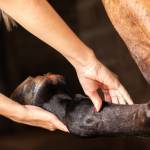Rehabilitation for Tendon Injuries in Horses: Stem Cells Useful

Although the best way to manage injuries to the superficial digital flexor tendon (SDFT) remains to be established, progress is being made on that front. A recent study shows that a single injection of bone marrow-derived cultures stem cells (BM-MSCs) into an injured SDFT followed by a controlled exercise rehabilitation program (CERP) has a better outcome than CERP alone.*
Because it is less elastic than healthy tendon tissue, scar tissue causes tendons to heal slowly, thus making them more susceptible to reinjury
“SDFT injuries occur commonly, affecting about one-quarter of all racehorses. Reinjury after treatment happens in up to half of those horses, even following prolonged rest and intensive rehabilitation,” explained Kathleen Crandell, Ph.D., a nutritionist for Kentucky Equine Research.
With the recent surge in regenerative medicine, many horses with SDFT injuries are being treated with stem cells.
One method involves collecting stem cells from the bone marrow of the patient and then sending those cells to a laboratory to be cultured. Ten million of the patient’s cultured cells are then injected directly into the lesion (i.e., site of injury within the tendon). It takes two to three weeks for the cells to be cultured. After injection, the horse then undergoes a standard CERP that lasts up to 12 months before training restarts.
To determine if stem cell therapy improves a horse’s chances of returning to racing, 213 Thoroughbreds with SDFT lesions were identified. All horses included in the study underwent a similar CERP lasting about 12 months. Sixty-six of those horses also received a single injection of cultured BM-MSCs at the start of the CERP.
“Horses treated with BM-MSCs were three times more likely to return to racing than horses that only underwent CERP. Further, BM-MSC-treated horses were over 2.5 times more likely to race five or more times after treatment,” Crandell said.
The data also showed that each additional centimeter in lesion length was associated with a 10% decrease in likelihood of return to racing.
“These data therefore support BM-MSCs in combination with CERP for an increase in the likelihood of return to racing,” summarized Crandell.
In addition to the tendon injury itself, concerns associated with the sudden layup also need to be considered.
“Considerable bone loss has been found in horses that are rested for an injury because of the lack of concussive forces on the bone tissues. Once they start a rehabilitation program, they need an array of bone-building nutrients, including magnesium, boron, silicon, iodine, zinc, and manganese, as well as vitamins A, C, D, and K to keep from injuring weakened skeletal tissue. Triacton provides these nutrients to horses and as such, is an appropriate supplement for injured horses subjected to a sudden layup,” explained Crandell.
She added, “In a study performed at Kentucky Equine Research, supplementing horses in race training with Triacton for 90 days resulted in a three-fold greater increase in dorsal (shin) cortical bone density compared to the horses that received a placebo.”
*Salz, R.O., C.R.B. Elliott, T. Zuffa, E.D. Bennet, and B.J. Ahern. 2023. Treatment of racehorse superficial digital flexor tendonitis: A comparison of stem cell treatments to controlled exercise rehabilitation in 213 cases. Equine Veterinary Journal. doi:10.111/evj.13922.








